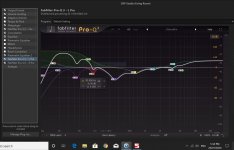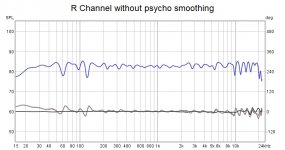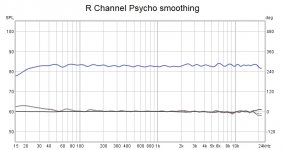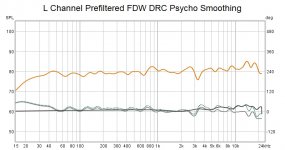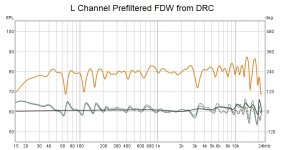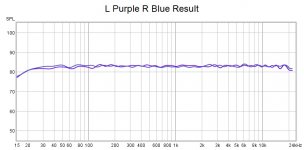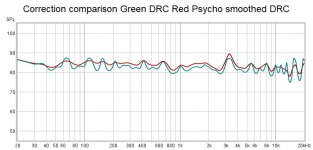That was my motivation, there will come a point when there are no 32 bit options. My comment on the sound was aimed at whether the transfer from PLPar to Equilibrium worked for youI don't expect an audible change by going 64 bit, it just makes sense to do so since a 64 bit OS has been around for more than a decade
Hope it helps. I think those figures are good for tweaking balance. Start flat and go from there. They are all 2nd order (12dB) shelves so minidsp should be able to do it easily. Can we still not tempt you into DRC for your version 2 arrays?Thanks for outlining your apporach, I might try somthing similar with my miniDSP2x4HD to test. I have a decent baseline at the moment but is not ´perfect´yet
Thanks MarkFluid, your panel looks great !
I figure you've probably seen this chart or certainly similar ones...I've found this one particularly handy. https://www.bobgolds.com/AbsorptionCoefficients.htm
fwiw, rigid compressed-fiberglass panels attached to same size thin luan plywood for wall or ceiling mounting, made for very easy fabric covering.
Also round compressed-fiberglass tubes, capped on the ends with mdf or ply have worked well as corner bass traps. Covered those with fabric too...
Good acoustic stuff at the HVAC trade supply houses...
I have seen that before, I am more limited by what is available to me where I live. There is nothing rigid with the right specifications, for a reasonable price. I found some Gas flow numbers on gearslutz for the stuff I could buy from the local big box hardware store. There was a surprising amount of variability in GFR among things that appeared similar.
For the big panels the MDF frames worked out well as they free stand quite nicely on their own, the room they are in is off limits for my son, I will have to fix them to the wall at some point though.
The last panel with the printed fabric picture was more of a compromise as I couldn't get it as deep as I wanted to match the others.
Can we still not tempt you into DRC for your version 2 arrays?
I am all ears, just show me the way
What I mean is, I am very unsure how to use these tools to my benefit best yet. I simply dont have the full picture
I have the miniDSP2x4HD and its upgradable to Dirac 2.0 for a $200 fee - I havent purchased that yet though. Required?
A brief, dumb-it-down explaination might be very useful!
I am all ears, just show me the way
What I mean is, I am very unsure how to use these tools to my benefit best yet. I simply dont have the full picture
I have the miniDSP2x4HD and its upgradable to Dirac 2.0 for a $200 fee - I havent purchased that yet though. Required?
A brief, dumb-it-down explaination might be very useful!
I read through your new thread as I wasn't up to date on it. I see you are using an AppleTV2 as a source. I use one myself for movies and TV in the family room, really nice device but it will be a limiting factor for this sort of DSP tweaking.
I had a look through the 2x4HD specs. It seems the $200 upgrade is to get Dirac Live software, doesn't seem to change the hardware at all. The hardware is capable of using 4 banks of 4096 tap filters and 10 PEQ's per input channel. I don't see the need for Dirac Live myself so I would hold off for now.
With careful use of those resources I think we could get somewhere close to the sort of thing wesayso and I have been running but it would require a different strategy to get the most out of them.
Are you able to bring a computer in as a source? That would make it easy
Even if you were just to use a laptop or something as a start it would help to get you in the ballpark and that would make it easier to know the target transfer function, then an approximation could be made using the minidsp EQ.
The downside to using an FIR that changes phase is latency. That will cause an issue with lipsync to the appletv. At 4096 taps that's around 43ms with a centred impulse, might be too much for good lipsync. From memory I think the threshold is 40ms.
Jriver can delay the video to match the audio which removes latency as an issue for stored content.
The basic version of what I do now is this.
Measure in the prime listening position at the exact sweet spot. I get that by playing both speakers at once and measuring with REW then moving the mic to see when the two impulse peaks come together as one. I use the mic pointed at the ceiling with a 90 degree calibration file.
Optional stage is to take measurements at different locations for an average. For now I have used a single point for simplicity and because it is working. I will go back to try averages again. With your treatment a single point should be OK for starters.
I use REW and apply a 15 cycle Frequency dependant window and 1/12 or 1/6 oct smoothing. I then use a combination of manual and auto EQ to get that fairly flat. I set the reference line to cut through where the mid boost from the array stops. I set a 24dB rolloff with a 30hz point to target for the low end. I start with manual shelving EQ (+16dB at 80Hz 12db Shelf
I measure again with that EQ in place to form my base measurement for DRC. I use a presaved sweep as file in Jriver and play that with the EQ on and REW measures it.
I export the impulse of that measurement per channel to a 32 bit wave file. Can be normalised or not. That is converted to a raw 32 bit file in audacity and the file extension changed to .pcm.
Run DRC with my template set to a flat frequency response and generate the filter.
I import those DRC filters into REW as impulses and convolve them with the base measurements to see the result. A*B on all spl and then reduce level by 80dB or so due to the multiplication. Doesn't matter on the value as long as you apply the same to both. I then use a 6 cycle FDW to view the result. If there is any channel imbalance I alter the level to get the best fit. I then add that offset into Jriver to make sure the channels are balanced.
Use that filter wave file in Jriver's convolver.
I then use the House Curve EQ over the top to take the flat measuring down to flat sounding.
There is also Mid Side EQ but that is not really possible with MinDSP.
Sounds worse than it is
If you want some help I'm happy to have a look at your raw measurements and see what I can come up with.
I am doing it this way now because it allows for flexibility in the processing stages if I want to try something different. There will be duplication cut and boost due to the different stages which is why I say you could get the overall transfer function with less resources, but it takes them in the first place to know what you want
Attachments
Thanks fluid, I know it wont be as "bad" as it sounds once I have done it - just havent gotten on top of it all yet 
I do have access to a laptop (use it for REW/miniDSP config) but I will not be using it as part of my signal chain.
What I have done so far is:
* Measure L+R individually, to get them close to eachother.
* Measure L+R together, get them to sum better (this is where I am lacking a bit at the moment) Have looked to rePhase but not started actual work.
* Establish a flat response between 100hz - 5khz and applied that to miniDSP Output PEQ. Response is flattened by cutting the peaks.
* Then apply a couple of low shelf/high shelf filters on miniDSP Input PEQ to generate a desireable house curve, judged by ear.
This have provided a pretty decent base line
I'll read and absorb your post, thanks for taking the time!
I do have access to a laptop (use it for REW/miniDSP config) but I will not be using it as part of my signal chain.
What I have done so far is:
* Measure L+R individually, to get them close to eachother.
* Measure L+R together, get them to sum better (this is where I am lacking a bit at the moment) Have looked to rePhase but not started actual work.
* Establish a flat response between 100hz - 5khz and applied that to miniDSP Output PEQ. Response is flattened by cutting the peaks.
* Then apply a couple of low shelf/high shelf filters on miniDSP Input PEQ to generate a desireable house curve, judged by ear.
This have provided a pretty decent base line
I'll read and absorb your post, thanks for taking the time!
If you want to take it further use the laptop or computer to output audio to your DAC for test purposes, it is much easier to get things setup the way you want them by tweaking the individual stages. When you are happy with that you can extract the EQ transfer function that you have created and then get as close to that as possible with the minidsp.
It is much harder to get the best result by moving all stages together. I know because I have tried
Another alternative is to export the 15 cycle and 1/12 or 1/6 oct filtered measurement as text and import that as a measurement in rephase and use rephase filters to get your desired response, by setting the filter to 4096 taps and generating the filter you can see how close it is to what you want. As long as you stay above 100Hz the filter should be pretty close, then you can use the PEQ in the MiniDSP to do the changes below 100Hz. If you want to try phase changes then after measuring you could use rephase again to generate a phase only correction to load into another FIR bank in the minidsp.
I would make the PEQ changes for the Minidsp by using REW's EQ Function as it can be set to the MiniDSP Q. Rephase uses different Q definitions and I'm not sure if they are compatible.
If you want I can generate you a filter to try and see if you like it. If nothing else it will give you something to work off. PM me if you want to give it a go.
It is much harder to get the best result by moving all stages together. I know because I have tried
Another alternative is to export the 15 cycle and 1/12 or 1/6 oct filtered measurement as text and import that as a measurement in rephase and use rephase filters to get your desired response, by setting the filter to 4096 taps and generating the filter you can see how close it is to what you want. As long as you stay above 100Hz the filter should be pretty close, then you can use the PEQ in the MiniDSP to do the changes below 100Hz. If you want to try phase changes then after measuring you could use rephase again to generate a phase only correction to load into another FIR bank in the minidsp.
I would make the PEQ changes for the Minidsp by using REW's EQ Function as it can be set to the MiniDSP Q. Rephase uses different Q definitions and I'm not sure if they are compatible.
If you want I can generate you a filter to try and see if you like it. If nothing else it will give you something to work off. PM me if you want to give it a go.
I like what I see here  . Halair, it just takes a bit of time to get the hang of it, you don't need the Dirac software, you've got all the stuff needed to get quite close to what we do with our PC's.
. Halair, it just takes a bit of time to get the hang of it, you don't need the Dirac software, you've got all the stuff needed to get quite close to what we do with our PC's.
Some good advice here by Fluid, take him up on his offer .
.
I'll help any way I can too. You could use DRC with a template that fits within your miniDSP. We can even reduce the amount of lag by moving around the impulse peak within the FIR filter. That does limit the possibilities to tweak details somewhat but it would still be plenty to get you close.
The idea of using the laptop to get going is a good one. We've also spoken about cutting back the A/D D/A steps needed. Digital in on the MiniDSP would be my preference. Use the MiniDSP as your DAC.
If we build it up, step by step you could easily learn how to conquer this on your own.
I'd suggest using that FIR part of the miniDSP to build up these steps.
- For example, get a good pré-EQ with REW and save that as a 4096 tap FIR correction, one for the left, one for the right. (actually 2 for left and two for right in your case with the two part array. Though treat one array as a whole, as inside the room it needs the other half to function as a full floor to ceiling array.)
- After making this correction, a second set of measurements is needed with the FIR pré EQ active. That measurement we can feed to DRC-FIR. The outcome of that FIR correction can be combined (convolved) with the pré EQ. So you'd still only have one FIR file that contains both pré EQ and DRC's corrections.
- Next up, we could use RePhase for setting a room curve and possibly some minor phase tweaks to get a good sum left and right. That can also be melted together with the earlier FIR file so we have one FIR correction that exists out of pré EQ, DRC correction and a room curve. Keeping the RePhase files and previous steps saved within REW should mean you can try out different curves in no time. It would just be a few simple REW tweaks away to try something new.
Now you'd still have the PEQ's available to tweak that possible last bit, like the bottom end, into shape. A lot of this stuff can be done with simulated runs on a PC based upon measured results. So either Fluid or me can help you with it, till you get the hang of it yourself. All it requires is some time and dedication to get good useful information about each step along the way.
Figuring out we can't see what you have so you have to describe in detail what you have and how you got it. That helps to be able to assist you from a distance. We're not there in the room with you, sadly enough.
Some good advice here by Fluid, take him up on his offer
I'll help any way I can too. You could use DRC with a template that fits within your miniDSP. We can even reduce the amount of lag by moving around the impulse peak within the FIR filter. That does limit the possibilities to tweak details somewhat but it would still be plenty to get you close.
The idea of using the laptop to get going is a good one. We've also spoken about cutting back the A/D D/A steps needed. Digital in on the MiniDSP would be my preference. Use the MiniDSP as your DAC.
If we build it up, step by step you could easily learn how to conquer this on your own.
I'd suggest using that FIR part of the miniDSP to build up these steps.
- For example, get a good pré-EQ with REW and save that as a 4096 tap FIR correction, one for the left, one for the right. (actually 2 for left and two for right in your case with the two part array. Though treat one array as a whole, as inside the room it needs the other half to function as a full floor to ceiling array.)
- After making this correction, a second set of measurements is needed with the FIR pré EQ active. That measurement we can feed to DRC-FIR. The outcome of that FIR correction can be combined (convolved) with the pré EQ. So you'd still only have one FIR file that contains both pré EQ and DRC's corrections.
- Next up, we could use RePhase for setting a room curve and possibly some minor phase tweaks to get a good sum left and right. That can also be melted together with the earlier FIR file so we have one FIR correction that exists out of pré EQ, DRC correction and a room curve. Keeping the RePhase files and previous steps saved within REW should mean you can try out different curves in no time. It would just be a few simple REW tweaks away to try something new.
Now you'd still have the PEQ's available to tweak that possible last bit, like the bottom end, into shape. A lot of this stuff can be done with simulated runs on a PC based upon measured results. So either Fluid or me can help you with it, till you get the hang of it yourself. All it requires is some time and dedication to get good useful information about each step along the way.
Figuring out we can't see what you have so you have to describe in detail what you have and how you got it. That helps to be able to assist you from a distance. We're not there in the room with you, sadly enough.
Last edited:
Just to elaborate on my current work flow:
When I measure / adjust I bypass my DAC and play straight from laptop to miniDSP. (At the same time I am connected to the miniDSP and can perform adjustments on the fly, re-measure and repeat if I want)
In REW, I use the Auto-EQ -> Match target to flatten the response and save that filter as text file. I can then import this to the miniDSP, either to the input PEQ or output PEQ. (Output PEQ chosen, then manually tweak input PEQ to get change curve to taste)
I have treated each array as one, both top/bottom half get same signal through a RCA Y-splitter. (keeping things simple and floor-ceiling uniformity)
When I want to enjoy the arrays I connect the miniDSP to my DAC and time flies The miniDSP is supposed to be able to control volume, when I get that working my currect DAC will be obsolete and I can run digital input directly from the ATV2.
The miniDSP is supposed to be able to control volume, when I get that working my currect DAC will be obsolete and I can run digital input directly from the ATV2.
BTW - I'll update my own thread with some screen shots and we can continue this development there
When I measure / adjust I bypass my DAC and play straight from laptop to miniDSP. (At the same time I am connected to the miniDSP and can perform adjustments on the fly, re-measure and repeat if I want)
In REW, I use the Auto-EQ -> Match target to flatten the response and save that filter as text file. I can then import this to the miniDSP, either to the input PEQ or output PEQ. (Output PEQ chosen, then manually tweak input PEQ to get change curve to taste)
I have treated each array as one, both top/bottom half get same signal through a RCA Y-splitter. (keeping things simple and floor-ceiling uniformity)
When I want to enjoy the arrays I connect the miniDSP to my DAC and time flies
BTW - I'll update my own thread with some screen shots and we can continue this development there
Last edited:
Only two pages ago I said I was going to leave things alone for a while, and the desire to tweak had been suppressed 
This post is partly to outline something that others might find useful but also as a reminder to myself of what I did as it is quite complicated
Helping Halair make some FIR filters got me looking at REW and thinking....
I have been in two minds since trying greg's psycho filters out, in that there is something to like about them and be gained from them. Ultimately the old style longer windows won out and went back on general rotation.
The longer window on the top end is used to help reconfigure the line from the arrival time differences of 25 drivers. Due to the impulse response inversion from DRC this is correcting for the combing pattern. That has bothered me and I know it is something that wesayso manually adjusts in his corrections. Replacing one comb with another doesn't make sense to me so I wanted to make a new filter where I didn't do that.
Prefiltered base measurement

Psycho smoothed prefiltered base measurement
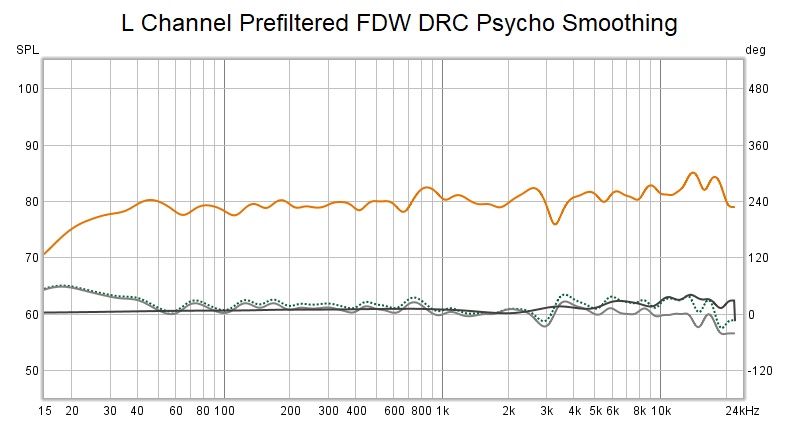
I wanted to keep the excess phase correction but adjust the magnitude of the filter to the spectral envelope. I tried with rephase and an exported version of the excess phase but I soon realised I was in for a lot of work trying to manually set the filters to remove the excess phase.
I remembered gmad's use of DRC to create an impulse version of a text file measurement. In short that uses a postfilter target which is the measured response you want and applies it to a Dirac pulse. That would allow me create an exact inverse filter for the excess phase. It was not quite as easy as it sounds as for some unknown reason DRC always outputs an odd rise to the high frequencies on a flat setting for me which translates into every filter it creates using this method too. My fix for that was to make a flat correction and create an inverse function in REW by using 1/A. Convolving that compensation with the generated filters gave me an exact copy of what I was aiming for Also DRC postfilter files can't have any text other than the measurement numbers, REW's comments and text must be removed. It seems to work better when there is a 0 line and a 22050 (half sample rate) line at the end. I just copied the values of the first and last measurement changing the frequency to 0 and 22050.
Also DRC postfilter files can't have any text other than the measurement numbers, REW's comments and text must be removed. It seems to work better when there is a 0 line and a 22050 (half sample rate) line at the end. I just copied the values of the first and last measurement changing the frequency to 0 and 22050.
Armed with this trick I imported my DRC filter and applied psychoacoustic smoothing to it. That looked much less spiky. So I exported that as a measurement. Turned it into an impulse with DRC and compensated it back. I then convolved that with the original prefiltered version of the base measurement. That wasn't quite right so I used REW's auto EQ to bring it back to flatter overall. Add that EQ to the filter and your done. When viewed through psychoacoustic smoothing there is almost no excess phase as DRC did a pretty good job the first time.
This is the right channel filter convolved with the pre-filtered measurement and psycho smoothing applied.
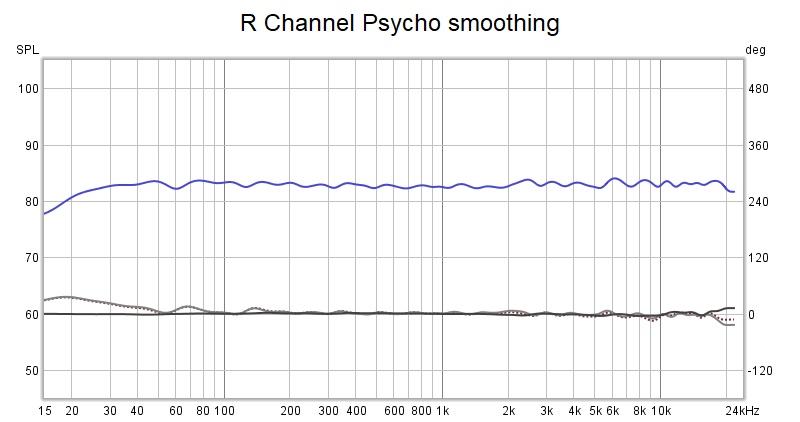
This is the same with the psycho smoothing turned off. This gave me what I was aiming for which is a fairly flat spectral envelope without filling in all the dips.
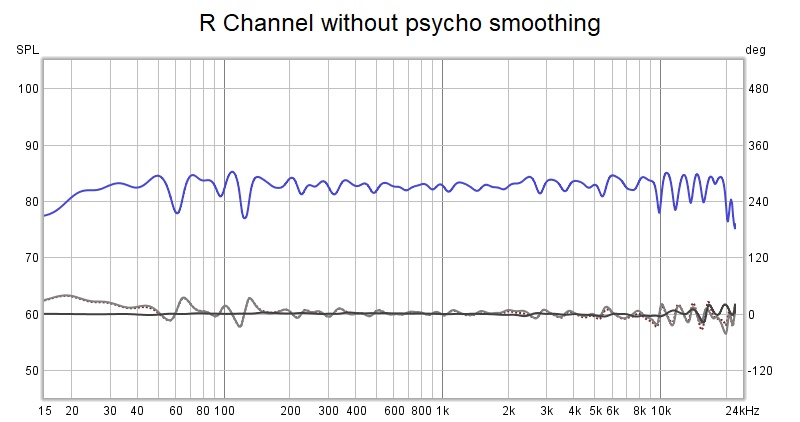
L R channel balance
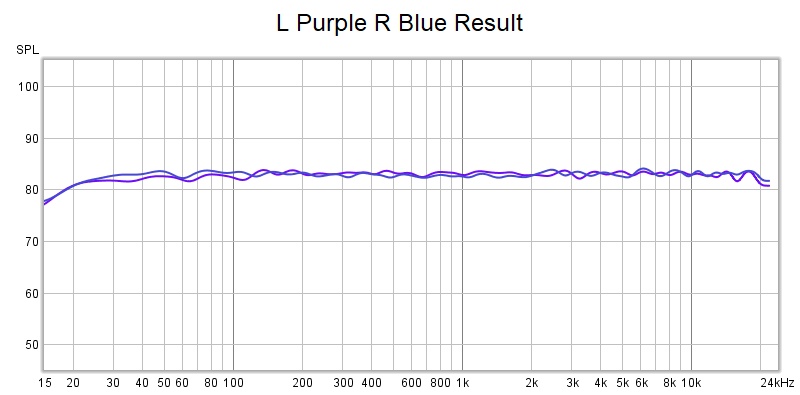
I have tried it and it sounds different. There is more apparent clarity and resolution but tonal balance has shifted, so as usual when changing the goalposts it might take a while to find out if different is better. If I can keep the good and re-balance it might be
This post is partly to outline something that others might find useful but also as a reminder to myself of what I did as it is quite complicated
Helping Halair make some FIR filters got me looking at REW and thinking....
I have been in two minds since trying greg's psycho filters out, in that there is something to like about them and be gained from them. Ultimately the old style longer windows won out and went back on general rotation.
The longer window on the top end is used to help reconfigure the line from the arrival time differences of 25 drivers. Due to the impulse response inversion from DRC this is correcting for the combing pattern. That has bothered me and I know it is something that wesayso manually adjusts in his corrections. Replacing one comb with another doesn't make sense to me so I wanted to make a new filter where I didn't do that.
Prefiltered base measurement
Psycho smoothed prefiltered base measurement
I wanted to keep the excess phase correction but adjust the magnitude of the filter to the spectral envelope. I tried with rephase and an exported version of the excess phase but I soon realised I was in for a lot of work trying to manually set the filters to remove the excess phase.
I remembered gmad's use of DRC to create an impulse version of a text file measurement. In short that uses a postfilter target which is the measured response you want and applies it to a Dirac pulse. That would allow me create an exact inverse filter for the excess phase. It was not quite as easy as it sounds as for some unknown reason DRC always outputs an odd rise to the high frequencies on a flat setting for me which translates into every filter it creates using this method too. My fix for that was to make a flat correction and create an inverse function in REW by using 1/A. Convolving that compensation with the generated filters gave me an exact copy of what I was aiming for
Armed with this trick I imported my DRC filter and applied psychoacoustic smoothing to it. That looked much less spiky. So I exported that as a measurement. Turned it into an impulse with DRC and compensated it back. I then convolved that with the original prefiltered version of the base measurement. That wasn't quite right so I used REW's auto EQ to bring it back to flatter overall. Add that EQ to the filter and your done. When viewed through psychoacoustic smoothing there is almost no excess phase as DRC did a pretty good job the first time.
This is the right channel filter convolved with the pre-filtered measurement and psycho smoothing applied.
This is the same with the psycho smoothing turned off. This gave me what I was aiming for which is a fairly flat spectral envelope without filling in all the dips.
L R channel balance
I have tried it and it sounds different. There is more apparent clarity and resolution but tonal balance has shifted, so as usual when changing the goalposts it might take a while to find out if different is better. If I can keep the good and re-balance it might be
Attachments
I'll try againCan't say these instructions were perfectly clear to me but I guess I see what you're doing.
This is the difference in the filters
The tonal balance has been set by ear in recent times and I haven't measured to see what the overall effect is.Did you try looking at a ~20 cycle FDW for setting the tonal balance? I found that to better represent the tonal balance I hear.
I will measure the in room difference between them and look at that through a 20 cycle FDW when I get a chance.
P.S. With the newer filter and Mid Side EQ turned off I have become quite well aware of the tonal change to the phantom centre. I think that is partly down to good channel matching. With the early reflections reduced it is quite obvious.
Attachments
Last edited:
That's a clever trick  . I like it. Might have to try it myself.
. I like it. Might have to try it myself.
My thoughts are that the tonal imbalance of this kind of setup with reduced early reflections is the reason why Toole was advocating the need some level of early reflections (while Geddes was saying the opposite to get the best imaging).
However I find the absense of those reflections with mid/side Eq added works even better to get great imaging while still having good/great tonal balance as well.
Works even better with a diffused haas kicker added to the mix. This preference might be personal though. As I read in another thread this may be called Mi-Fi instead of Hi-Fi .
.
My thoughts are that the tonal imbalance of this kind of setup with reduced early reflections is the reason why Toole was advocating the need some level of early reflections (while Geddes was saying the opposite to get the best imaging).
However I find the absense of those reflections with mid/side Eq added works even better to get great imaging while still having good/great tonal balance as well.
Works even better with a diffused haas kicker added to the mix. This preference might be personal though. As I read in another thread this may be called Mi-Fi instead of Hi-Fi
That's a clever trick. I like it. Might have to try it myself.
This is where gmad introduced the idea. I managed to make the same mistake twice by using a stereo dirac pulse combined to one when exported raw. A single mono pulse as the base measurement removed the high tilt I was getting.
A convolution based alternative to electrical loudspeaker correction networks
I think it is useful to be able to turn a frequency response into an impulse.
Possibly, but the more of his newer book I read it sounds to me that people really like spaciousness (it's more important to them than most other aspects given the choice) and that usually comes from early reflections which can broaden the image at the same time, it is one of those things that sounds less accurate to me as a description but more people tend to prefer it.My thoughts are that the tonal imbalance of this kind of setup with reduced early reflections is the reason why Toole was advocating the need some level of early reflections (while Geddes was saying the opposite to get the best imaging).
However I find the absense of those reflections with mid/side Eq added works even better to get great imaging while still having good/great tonal balance as well.
Works even better with a diffused haas kicker added to the mix. This preference might be personal though. As I read in another thread this may be called Mi-Fi instead of Hi-Fi.
I have experienced myself a much improved imaging experience with my arrays pointing more straight at me and with reduced reflections. Panning in tracks used to almost annoy me before but now I quite like it. I am also getting very definite height positions with certain instruments in certain tracks, never noticed that before.
I am keen to try the ambience with reduced early reflections as to me it sounds like the best of both ideas combined. Sharper imaging but still with spaciousness and width from the kicker.
Mifi seems like a good idea until someone is able to create a calibration for speakers in rooms that works as well as a mic calibration does.
Somehow I missed or forgot or didn't think about the fact that DRC does impulse response inversion. I thought about it as something that equalized in the frequency domain. It is more correct to think of it as something that massages the frequency response first and then inverts the IR of the massaged result. I now realize I have to invert the IR at some point to get the flat phase in the bass that both your response show.
Going to the link in Fluid's last post, I don't understand one step of that process
"Apply speaker calibration file". What is meant by "apply"?
I know we want a filter freq. response such that the speaker response times the filter response equals the target response. Turning that into an equation and rearranging, we then have FILTER = TARGET/SPKR , where SPKR is the measurement. That would make sense to me as the apply step and it contains the necessary IR inversion.
Since I have a DRC aversion (due to lack of understanding of what it does and how it does it) I've been avoiding it, using just REW and Rephase and converting FRs to IRs in Vituix. You draw a schematic that has just a source and a drver. You point the tool at the frequency response and using a drop down menu on the main screen ask Vituix to show you the IR, which you can then export. Actually, maybe its a command line aversion I have
Anyway thanks for this discussion, some of it is starting to get through to me.
Going to the link in Fluid's last post, I don't understand one step of that process
"Apply speaker calibration file". What is meant by "apply"?
I know we want a filter freq. response such that the speaker response times the filter response equals the target response. Turning that into an equation and rearranging, we then have FILTER = TARGET/SPKR , where SPKR is the measurement. That would make sense to me as the apply step and it contains the necessary IR inversion.
Since I have a DRC aversion (due to lack of understanding of what it does and how it does it) I've been avoiding it, using just REW and Rephase and converting FRs to IRs in Vituix. You draw a schematic that has just a source and a drver. You point the tool at the frequency response and using a drop down menu on the main screen ask Vituix to show you the IR, which you can then export. Actually, maybe its a command line aversion I have
Anyway thanks for this discussion, some of it is starting to get through to me.
Possibly, but the more of his newer book I read it sounds to me that people really like spaciousness (it's more important to them than most other aspects given the choice) and that usually comes from early reflections which can broaden the image at the same time, it is one of those things that sounds less accurate to me as a description but more people tend to prefer it.
I have experienced myself a much improved imaging experience with my arrays pointing more straight at me and with reduced reflections. Panning in tracks used to almost annoy me before but now I quite like it. I am also getting very definite height positions with certain instruments in certain tracks, never noticed that before.
I am keen to try the ambience with reduced early reflections as to me it sounds like the best of both ideas combined. Sharper imaging but still with spaciousness and width from the kicker.
Mifi seems like a good idea until someone is able to create a calibration for speakers in rooms that works as well as a mic calibration does.
I set out to find my preferred way of tonal balance / imaging and envelopment. Using the known theory of Toole, Geddes, even a healthy dose of Griesinger's theory thrown in it has brought me to the mix I use today. Lots of other influences as well along the way, most notably the influence of the theory lessons from member werewolf (/lycan), long ago on another forum.
I've basically tried to find my own optimum mix of most of the theory that's out there
In hindsight, I kind of like the restrictions I've had to battle in my room as it meant I needed to work harder to get what I wanted, but ultimately it gave me more control with stuff like that virtual Haas kicker etc.
I get it why people like that spaciousness. But I'm glad to have found a way to get that without losing the benefits of lowered early reflection levels.
If your results mimic mine in any way you'll be surprised what tiny differences you can actually hear/pick up on.
You don't have to invert the IR but if you want any filter for magnitude, phase or both to be an exact match inversion is easier.Somehow I missed or forgot or didn't think about the fact that DRC does impulse response inversion. I thought about it as something that equalized in the frequency domain. It is more correct to think of it as something that massages the frequency response first and then inverts the IR of the massaged result. I now realize I have to invert the IR at some point to get the flat phase in the bass that both your response show.
What DRC offered in the experiment above was the ability to change the length of the FDW in a more flexible way than just in fractional octaves. You set the bottom window and the top windows separately and adjust the window exponent to bend it the way you want in between.
To me apply just means convolve. A*B in REW and a volume reduction if necessary. The full process there is different to what I have been using but that is where creating an impulse from a text file came from.Going to the link in Fluid's last post, I don't understand one step of that process
"Apply speaker calibration file". What is meant by "apply"?
The tricky part is getting the right values to enter for target and speakerI know we want a filter freq. response such that the speaker response times the filter response equals the target response. Turning that into an equation and rearranging, we then have FILTER = TARGET/SPKR , where SPKR is the measurement. That would make sense to me as the apply step and it contains the necessary IR inversion.
Since I have a DRC aversion (due to lack of understanding of what it does and how it does it) I've been avoiding it, using just REW and Rephase and converting FRs to IRs in Vituix. You draw a schematic that has just a source and a drver. You point the tool at the frequency response and using a drop down menu on the main screen ask Vituix to show you the IR, which you can then export. Actually, maybe its a command line aversion I have
This is a copy from the DRC FIR Documentation on the different stages available in the processing:
1. Initial windowing and normalization of the input impulse response.
2. Optional microphone compensation.
3. Initial dip limiting to prevent numerical instabilities during homomorphic
deconvolution.
4. Decomposition into minimum phase and excess phase components using
homomorphic deconvolution.
5. Prefiltering of the minimum phase component with frequency dependent
windowing.
6. Frequency response dip limiting of the minimum phase component to
prevent numerical instabilities during the inversion step.
7. Prefiltering of the excess phase component with frequency dependent
windowing.
8. Normalization and convolution of the preprocessed minimum phase and
excess phase components (optional starting from version 2.0.0).
9. Impulse response inversion through least square techniques or fast
deconvolution.
10. Optional computation of a psychoacoustic target response based on the
magnitude response envelope of the corrected impulse response.
11. Frequency response peak limiting to prevent speaker and amplification
overload.
12. Ringing truncation with frequency dependent windowing to remove any
unwanted excessive ringing caused by the inversion stage and the peak
limiting stage.
13. Postfiltering to remove uncorrectable (subsonic and ultrasonic) bands and
to provide the final target frequency response.
14. Optional generation of a minimum phase version of the correction filter.
15. Final optional test convolution of the correction filter with the input
impulse response.
It is very flexible and therefore it is somewhat complicated. Using batch files helps to automate creating filters and changing parameters. I use gmad's file and folder setup from the linked thread which I find easier. I had no previous experience with any of the other methods of using it.
I won't say it is easy because I still get it wrong, but it does begin to make sense after a while
...My thoughts are that the tonal imbalance of this kind of setup with reduced early reflections is the reason why Toole was advocating the need some level of early reflections (while Geddes was saying the opposite to get the best imaging).
However I find the absense of those reflections with mid/side Eq added works even better to get great imaging while still having good/great tonal balance as well...
... Possibly, but the more of his newer book I read it sounds to me that people really like spaciousness (it's more important to them than most other aspects given the choice) and that usually comes from early reflections which can broaden the image at the same time, it is one of those things that sounds less accurate to me as a description but more people tend to prefer it.
I have experienced myself a much improved imaging experience with my arrays pointing more straight at me and with reduced reflections. Panning in tracks used to almost annoy me before but now I quite like it. I am also getting very definite height positions with certain instruments in certain tracks, never noticed that before.
I am keen to try the ambience with reduced early reflections as to me it sounds like the best of both ideas combined. Sharper imaging but still with spaciousness and width from the kicker....
Pretty early on I think Toole concluded that multichannel audio (done properly) delivers spaciousness and envelopment with direct sound only, whereas 2-channel cannot and needs reflections as a crutch. That's very important when deciding on your speaker alignment and room treatment.
It is a mistake to think that, for 2-channel spaciousness, 'early' reflections means the near side wall. The opposite side wall still counts as 'early' (15 ms), in our small home spaces; so does bouncing twice off opposing side walls. Therefore the Geddes arrangement still delivers 2-channel spaciousness as per Toole. There is no contradiction. So there is no need to compromise or 'balance' any conflicts.
Now: imaging. There is a risk, if you place wide dispersion speakers so they strongly reflect off the near side wall, that the reflection is so early that it enters the very early (2-3 ms) category, which is perceived negatively as one wide sound source with combed FR and smeared position, hence poor imaging. Some of you are confirming this with your reports, albeit sighted.
In conclusion, I don't think there is a need for compromise in this area for 2-channel: use the Geddes setup and know you aren't compromising Toole. For multichannel (including the 'ambience' I see you mentioning -- if well done), your options open right up, and significantly more absorption becomes viable.
cheers
I cannot disagree with all those points made, but for my specific room + system I simply don't have the space/room to work on that to my benefit.
On my thread I've posted some pictures of the rooms Toole talks about. I don't have a room anywhere near that size and as it's a living room I cannot change all of it's properties to fit my goals .
.
As to multichannel having spaciousness and envelopment with direct sound only, that we can mimic with 2 channel audio and added ambience. Which is what I've done, basically.
Geddes has a better room too, where his CD speakers help to achieve what he's after. Geddes is a proponent of the LEDE concept and I'd have to agree it is a good choice for a listening environment.
The charm of the arrays is that it doesn't take a whole lot, to change the properties of the direct vs reflected wave front to make it fit our needs.
I have experimented with added ambience in a couple of ways. Have the virtual speakers mimic real rooms by using IR's of known good spaces vs using artificially created ambience, most notably 'Lecicon Random Hall'.
Both experiments were well worth it (*), but I do have a strong preference for the latter. The experiment with the IR's from known good spaces basically added the same signature on every song played. Much as a real room would, granted that our brain would not lock onto that coming from a real room as easily as these virtual additions. A lot of people hardly notice their room at all. At least they aren't fully aware of what it does. (they rather blame the recordings)
These virtual ambience speakers can add envelopment and assist with the cross talk present in stereo, the spacious part I link to the mid/side EQ plus the fill of the cross talk dips the laterally added (virtual) ambience adds.
Even without the ambience channels I can still have spaciousness but not the envelopment (after placing the absorption panels). The spaciousness only works if the song already has these properties. So it varies with each song played.
Fixed distance true room reflections sure work different compared to that. I haven't always had damping panels .
.
Adding the ambience channels enhances that 'spaciousness effect' and offers an opportunity of added 'envelopment'. All customizable to taste.
All in all, not a bad deal to have in a not so great room .
.
(*)= everyone with a room with low (absorbed) level early reflections and added virtual enhancement should play with real room IR's. It is a lot of fun as an experiment.
A worthwhile lesson in spaces and what they do. Not a substitute for real spaces but well worth it.
On my thread I've posted some pictures of the rooms Toole talks about. I don't have a room anywhere near that size and as it's a living room I cannot change all of it's properties to fit my goals
As to multichannel having spaciousness and envelopment with direct sound only, that we can mimic with 2 channel audio and added ambience. Which is what I've done, basically.
Geddes has a better room too, where his CD speakers help to achieve what he's after. Geddes is a proponent of the LEDE concept and I'd have to agree it is a good choice for a listening environment.
The charm of the arrays is that it doesn't take a whole lot, to change the properties of the direct vs reflected wave front to make it fit our needs.
I have experimented with added ambience in a couple of ways. Have the virtual speakers mimic real rooms by using IR's of known good spaces vs using artificially created ambience, most notably 'Lecicon Random Hall'.
Both experiments were well worth it (*), but I do have a strong preference for the latter. The experiment with the IR's from known good spaces basically added the same signature on every song played. Much as a real room would, granted that our brain would not lock onto that coming from a real room as easily as these virtual additions. A lot of people hardly notice their room at all. At least they aren't fully aware of what it does. (they rather blame the recordings)
These virtual ambience speakers can add envelopment and assist with the cross talk present in stereo, the spacious part I link to the mid/side EQ plus the fill of the cross talk dips the laterally added (virtual) ambience adds.
Even without the ambience channels I can still have spaciousness but not the envelopment (after placing the absorption panels). The spaciousness only works if the song already has these properties. So it varies with each song played.
Fixed distance true room reflections sure work different compared to that. I haven't always had damping panels
Adding the ambience channels enhances that 'spaciousness effect' and offers an opportunity of added 'envelopment'. All customizable to taste.
All in all, not a bad deal to have in a not so great room
(*)= everyone with a room with low (absorbed) level early reflections and added virtual enhancement should play with real room IR's. It is a lot of fun as an experiment.
A worthwhile lesson in spaces and what they do. Not a substitute for real spaces but well worth it.
Last edited:
I don't find anything to disagree with in your comments in general terms but I'm not sure how you pulled some of those thoughts out of what was written above.

Toole has a section in his third edition book where he explains some of his position further as parts of his writings have been taken by some to mean something other than he intended.
Geddes advocates for speakers with narrower directivity than full range lines allow. His positioning relates to that as well as avoiding the on axis dip from the round waveguide used. Coincidentally now I have aimed my speakers more directly at the listening position I have moved further in that direction where the far sidewalls are getting more excitation that before.
I don't think it is a matter of following one persons advice vs another. Both have much to offer but it is always a good idea to try and understand why they came to their conclusions and if that will actually apply in all situations.
I only share my own experiences in this thread so they are all sighted albeit with as little bias as I can manage. I don't expect anyone to take them as anything else but if we could only discuss properly conducted double blind trials it would be pretty quiet.
Of course that is always subject to change and I have a lot of spare fibreglass sitting in my shed
It makes sense that multichannel audio has the potential to create a much more immersive environment (and also closer to what the artist or mixer intended). In practice there is little music content made for it and upmixing existing content seems to be hit and miss for those that have tried it. The closest I will get to it is rear ambiance speakers, and I think they can be made to add some of that spatial context in an otherwise 2 channel stereo setup.Pretty early on I think Toole concluded that multichannel audio (done properly) delivers spaciousness and envelopment with direct sound only, whereas 2-channel cannot and needs reflections as a crutch. That's very important when deciding on your speaker alignment and room treatment.
I would classify early reflections either based on time or as in spinorama early reflections. I'm not sure where the idea of 'early meaning near sidewall only' came from anything written by meIt is a mistake to think that, for 2-channel spaciousness, 'early' reflections means the near side wall. The opposite side wall still counts as 'early' (15 ms), in our small home spaces; so does bouncing twice off opposing side walls. Therefore the Geddes arrangement still delivers 2-channel spaciousness as per Toole. There is no contradiction. So there is no need to compromise or 'balance' any conflicts.
Toole has a section in his third edition book where he explains some of his position further as parts of his writings have been taken by some to mean something other than he intended.
Geddes advocates for speakers with narrower directivity than full range lines allow. His positioning relates to that as well as avoiding the on axis dip from the round waveguide used. Coincidentally now I have aimed my speakers more directly at the listening position I have moved further in that direction where the far sidewalls are getting more excitation that before.
I don't think it is a matter of following one persons advice vs another. Both have much to offer but it is always a good idea to try and understand why they came to their conclusions and if that will actually apply in all situations.
My speakers have been more than a metre away from sidewalls everywhere I have used them, so is this comment aimed at someone else?Now: imaging. There is a risk, if you place wide dispersion speakers so they strongly reflect off the near side wall, that the reflection is so early that it enters the very early (2-3 ms) category, which is perceived negatively as one wide sound source with combed FR and smeared position, hence poor imaging. Some of you are confirming this with your reports, albeit sighted.
I only share my own experiences in this thread so they are all sighted albeit with as little bias as I can manage. I don't expect anyone to take them as anything else but if we could only discuss properly conducted double blind trials it would be pretty quiet.
I'm happy with the level of absorption I have now. I have used 150 mm to 180 mm with air gaps to make sure that the absorption is broadband down to below the transition and is not just EQ'ing the reflections.In conclusion, I don't think there is a need for compromise in this area for 2-channel: use the Geddes setup and know you aren't compromising Toole. For multichannel (including the 'ambience' I see you mentioning -- if well done), your options open right up, and significantly more absorption becomes viable.
cheers
Of course that is always subject to change and I have a lot of spare fibreglass sitting in my shed
Hahaha like fluid I too was wondering about some of the remarks made here. So where are the setups with very early reflections? Who are the "some"? And based on what? I'd rather let the measurements tell that story.
When talking about early reflections there's still a profound difference between those arriving at ~6-7 ms and ones that arrive after 10-15 ms.
Even the direction of those reflections does have some influence on what we perceive.
We do what we can within the confounds of our own space. We share what works for us which may be of benefits to others. The power of DIY is just that for me. We can somewhat control how our speaker(s) react within our own space and cater for that. It's quite different for a manufacturer which has no control over where their speakers end up. Do I envy the guys with elaborate huge listening spaces? I don't know. I see many rooms on the net featuring the so called high end that don't impress me. Sure I'd like to play in other sized rooms. But it's not what I have so I make the best of what I've got. Your mileage may vary...
When talking about early reflections there's still a profound difference between those arriving at ~6-7 ms and ones that arrive after 10-15 ms.
Even the direction of those reflections does have some influence on what we perceive.
We do what we can within the confounds of our own space. We share what works for us which may be of benefits to others. The power of DIY is just that for me. We can somewhat control how our speaker(s) react within our own space and cater for that. It's quite different for a manufacturer which has no control over where their speakers end up. Do I envy the guys with elaborate huge listening spaces? I don't know. I see many rooms on the net featuring the so called high end that don't impress me. Sure I'd like to play in other sized rooms. But it's not what I have so I make the best of what I've got. Your mileage may vary...
- Home
- Loudspeakers
- Full Range
- Full Range TC9 Line Array CNC Cabinet
